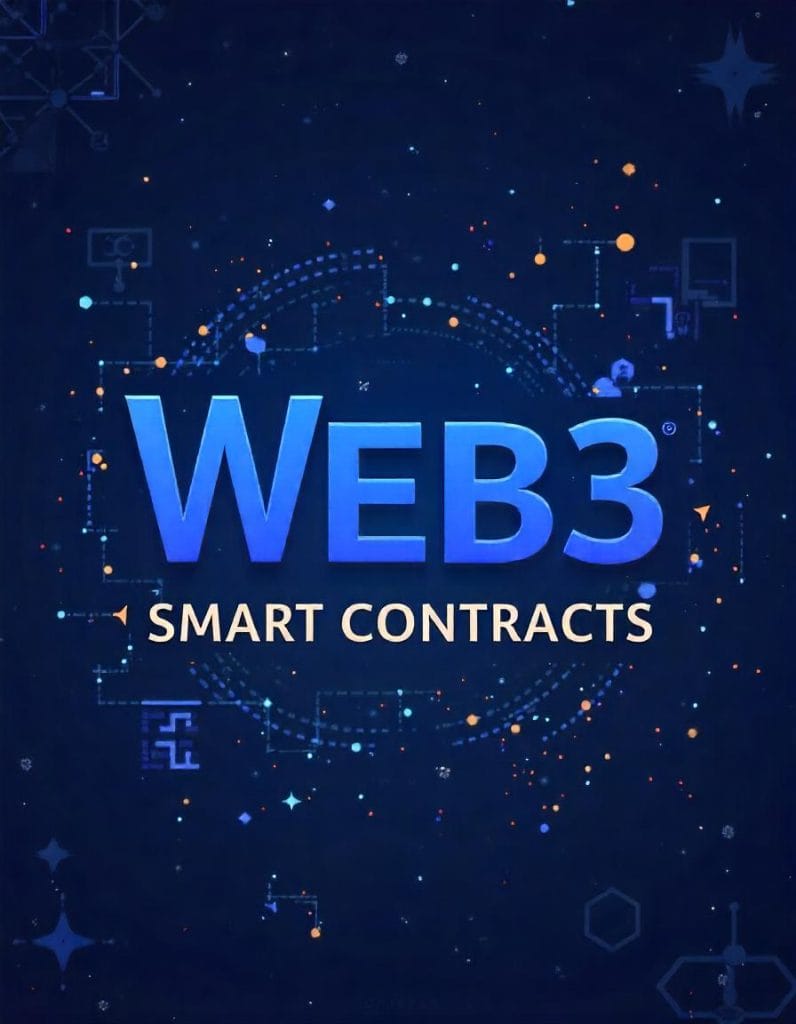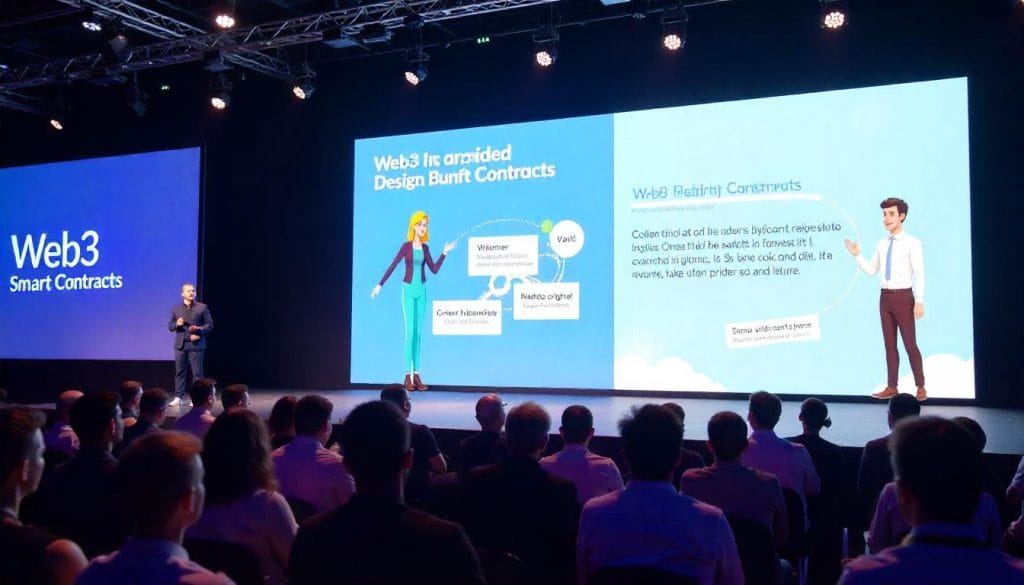One of the most significant consequences of Web3 smart contracts is the new way transactions are carried out. In the Web3 age, decentralization is the central concept behind success, and smart contracts play an essential role through secure, fully automated, and transparent agreements. Web3 smart contracts are decentralized applications that run on blockchain services and are inherent in terms of self-execution. They are programmed to run automatically when certain terms are met, leaving third parties such as banks, legal representatives, or any other intermediaries redundant. This development in blockchain technology is bringing major changes to many sectors, spanning from finance to the process of supply chain management and farther. In this article, we will see what Web3 smart contracts are, how they work, their real-world applications, challenges, and their potential in building the future of digital transactions.
Web3 smart contracts are a kind of a self-executing contract which involved an agreement where the terms were written in code and then stored on a blockchain. These contracts work automatically, eliminating the need for trust between the parties, with the blockchain technology being the facilitating factor.
The concept of Web3 smart contracts evolved from the idea that cryptologist Nick Szabo envisioned in the 1990s. He thought the idea of self-executed contracts where the contract would be automatically executed when certain conditions were met, and the intermediaries would be unnecessary. Presently, middleman-free blockchain networks such as Ethereum, Binance Smart Chain, and Solana are nurturing smart contract implementation for various use cases.
Core Web3 smart components consist of smart contracts is:-
- Code Execution: Web3 smart contractsexcecute particular predetermined commands that enforce the agreement agreed without manual intervention.
- Immutability: As soon as the Web3 smart contracts are deployed on the blockchain, they are MPV. There are not any changes possibility which satisfies the case of being transparent and secure plus immutable.
- Automation: Transactions start triggering when they are executed. Thus, this step ensures that no human beings are to intervene in the process, meaning there will not be any errors or slow down of transactions.

How Web3 Enhances Smart Contracts
Web3 smart contracts are decentralized servers that are not prone to human errors or fraud, unlike central servers which are run by a single entity. They utilize technology that allows for quick, secure, and frictionless transactions. Among the reasons why Web3 is more than a generation is that it is the first one to have interoperable blockchain networks, meaning smart contracts can be digitech, scan, to, finance, and nft of different networks serving a different purpose. They also enable multiple applications to interact together, and conditionally, a blockchain is a TIC TAC TOE game. The decentralized eco-system powered by blockchain is a game-changing concept that has impacted various sectors.
Yet, the existing blockchain is typically paternal as key players design and maintain protocols. This results in the absolute power being held by a few and preventing them from making a move to disrupt the network. The primary way Web3 improves smart contracts is through decentralization, ensuring that no single entity can meddle with the process. Web3 smart is a prime example of how blockchain technology guarantees a safe and interoperable system as with other blockchain frameworks.
Web3 smart contracts are ideal for reducing the role of intermediaries, the expertise needed to complete transactions, and, while still maintaining security, the otherwise extortionate fees many pay in transactions of value. By using blockchain functions for such purposes, Web3 will impersonate the ideal to lower the barrier to entry of users due to the absence of intermediaries. A most valid example is the decrease in mobile data costs that took place in Africa due to the use of blockchain for data purchasing. There is no need for any intermediaries that cause the prices to go up.
Real-World Applications of Web3 Smart Contracts
Web3 smart contracts are now mostly introduced to different sectors, which is responsible for making flow of transactions and agreements in the distributed network more efficient. Some of the most influential applications include:
1. Finance & DeFi (Decentralized Finance)
Web3 smart contracts are key elements of the DeFi space here, allowing decentralized lending, margin trading, staking, and yield farming. Platforms such as Aave and Compound are available for people to lend in the form of smart contracts. A program code which deals with the issuance of the loan without banks is one of the things the smart contract does automatically. Users can give a smart contract power to automatically pay interest as well as liquidate collateral during a loss of the loan.
2. Supply Chain Management
Web3 smart contracts grant the possibility of the supply chain transparency growth by registering every single product’s movement on a blockchain. Security is guaranteed by the system itself. All operations are carried out in real time. Fraud, counterfeiting, and inefficiencies are minimized. Companies like IBM and VeChain are among the ones that track shipments and product authentication through smart contracts systems.
3. NFTs & Digital Ownership
Web3 smart contracts give birth to non-fungible tokens (NFTs) which are the pieces to digital ownership of art, music, and virtual assets. Platforms like OpenSea and Rarible impose smart contracts for verification and automated digital asset transfer, thus allowing the artist to get his content monetized without intermediaries.
4. Gaming & Metaverse
Web3 smart contracts are responsible for providing digital gaming a new meaning by permitting gamers to deeply own in-game valuable goods, trade virtual goods, or be part of a play-to-earn economy. Blockchain-based games such as Axie Infinity and The Sandbox use smart contracts to manage the possession of assets as well as the distribution of the reward in the area of the game.
5. Real Estate Transactions
The Web3 smart contracts are working on real estate transactions in the paperwork elimination and the fraud risk reduction. Agencies such as Propy provide the property transfers through the use of the smart contracts, ensuring guarded and transparent transactions between the buyers and the sellers.
Challenges and Limitations
Although Web3 smart contracts come with so many benefits it has some downsides. Some of the major drawbacks are:
1. Scalability and High Transaction Fees
The issue of scalability in the case of blockchains like Ethereum is largely responsible for the high gas fees of smart contract transactions. Second layer solutions such as Polygon and Optimistic Rollups aspire to enhance the situation by guaranteeing faster transactions.
2. Security Risks and Vulnerabilities
Web3 smart contracts, on the other hand, can be broken into if not coded properly. The most affected security breaches from time to time like the DAO hack in 2016 show the necessity of comprehensive security audits and strong development practices.
3. Legal and Regulatory Concerns
The legal framework governing Web3 smart contracts is continuously evolving. Some areas are having no regulations at all. Lack of clear regulations can bring uncertainty as far as their applicability is concerned. However, governments are in the process of trying to find a way to allow the technology to be used without removing the important aspect of creating a secure environment for consumers.
The Future of Trustless Transactions
Web3 smart contracts are posed to disrupt the way transactions are being done in the digital age. The adoption of this technology is achieved only through regulation and the improvement of the related tools, processes, and systems with state-of-the-art technologies.
1. Layer 2 Scaling Solutions
Layer 2 technologies to build smart contracts are a perfect example. Apart from reducing the cost of transactions by utilizing Arbitrum and zk-Rollups, this move will ensure the applications run faster and blockchain-based transactions become even more affordable and efficient.
2. Cross-Chain Interoperability
Using web3 contracts, the virtual world is no longer confined to one blockchain and can be present in all its forms across different networks. Polkadot and Cosmos the chains on which these projects run and offer a totally new way to interact between different ledgers.
3. Mainstream Adoption in Enterprises
Web 3.0 smart contracts approach solves two major problems faced in larger companies and organizations. As businesses continuously mature and technologies such as AI find their way into various domains, industries such as healthcare, legal, and finance will be one of the biggest sectors that smart contracts will introduce.
4. AI and Smart Contracts Integration
AI integrated into smart contracts gives us the possibility of their continuous development and enhancement. This ensures next-level automation and decision-making efficiency.
Conclusion
Web3 smart contracts are, in fact, a serious change in the way digital transactions and contracts are being done, being faster and secure than the existing ones. The blockchain will evolve to bring not only transparent transactions, but smart contract technology will also put everything to automation in the industries.
Web3 smart contracts will become more mainstream due to the improving scalability, security, and regulation, which will allow them to overcome the current obstacles. Businesses and individuals, who wish to be at the forefront of the Web3 age, should not let pass a big opportunity of smart contracts in improvements of their operations, cost reduction and the reliability of unticketed transactions. The world decentralization, and the Web3 smart contracts are the main thing of this shift.

